Conjugated microporous polymer membranes for chemical separations
Zongyao Zhou, Zhen Li, Lubna M.Rehman, Zhiping Lai
Division of Physical Science and Engineering, King Abdullah University of Science and Technology (KAUST), Thuwal 23955-6900, Saudi Arabia
Keywords:Conjugated microporous polymer Membrane Separation Electropolymerization Film
ABSTRACT Conjugated microporous polymers(CMPs)are a unique class of porous organic materials,which are constructed with π-conjugation structures leading to intrinsic micropores.The CMPs properties such as high surface area,intrinsic and rich micropores,interlocking and rigid structure,extensive π-conjugation and tunable band-gap,chemical and thermal stability,together with tailored functionalities,contribute to its abundant potential for application in fields such as photocatalysis, optoelectronics, energy storage, and chemical sensors.Recently, CMPs have gained importance in the field of membranes for chemical separation.In this review, we briefly discuss the historical development of CMPs, followed by a detailed description of the progress in state-of-the-art design, preparation, and application of CMPs in membranes.Additionally, we provide inference on the future prospects of CMPs as membranes.
1.Introduction
Since the late 1960s,membrane systems have been extensively used in chemical separation technologies due to several advantages over conventional separation processes: high energy efficiency, short operation time, environmental benignity, and small footprint [1-3].The advent of porous materials has played a remarkable role in developing high-performance membranes [4-6].To achieve precise chemical separation,a narrow pore size distribution and high porosity of the porous membranes are indispensable [7-9].Therefore, membranes made of crystalline porous materials, such as zeolites [10-13], metal-organic frameworks(MOFs) [14-17], and covalent organic frameworks (COFs) [18-21],have gained enormous attention in the field of chemical separation.However, it is very challenging to prepare membranes out of these porous materials without defects [22-24].In addition,the cost is also higher when compared with conventional amorphous polymers [25,26].These drawbacks have hindered their practical applications.
On the other hand, conventional amorphous polymers such as polysulfone (PSf), polyvinylidene fluoride (PVDF), and even the emerging polymers of intrinsic microporosity (PIMs) can be easily processed and at low cost [27,28].However, the uniformity of the membrane pores remains unachieved due to the structural relaxation that originates from the flexibility of the polymer chains[29].As a result, the wide pore size distribution and low porosity have limited their separation performance.
Recently, a novel type of polymers, conjugated microporous polymers (CMPs), have exhibited impressive rigid structure with the π-conjugated system [30-32].The membranes/films made from CMPs showed uniform pore size distribution and high surface area, which is comparable to the COF and MOF membranes [7].In addition, CMP membranes have excellent chemical and thermal stability [33,34].All these properties are favorable for chemical separation applications.
Since the discovery of the first CMP in 2007 [35], a vast literature on various synthesis routes and applications of CMPs have been published, which covers fields such as photoelectricity [36-39], catalysis [40-44], chemosensors [45-47], separation and adsorption[48-52],energy storage[53-55],and biological applications[56-58].However,very few reviews focus on the latest developments of CMP membranes for chemical separation.This review is aimed to cover this knowledge gap.The structure of the review is illustrated in Fig.1.It will first briefly introduce the historical development of CMPs and their synthesis methods.Then,we focus on the recent progress of CMP membranes for chemical separations, including the fabrication routes and applications.Finally, a plausible conclusion, future development, and outlook of CMP membranes are given.

Fig.1. Illustration of the scope of the review.The review focuses on the development of CMP membranes.
2.Historical Development of CMPs
The first CMP (CMP-1) was reported in 2007 by Cooper’s groupviathe Sonogashira-Hagihara cross-coupling reaction [35].The CMP network possesses extended π-conjugation throughout the entire porous structure, making it unique from other porous polymer materials [35,59].Since then, the number of publications has increased rapidly, as shown in Fig.2.
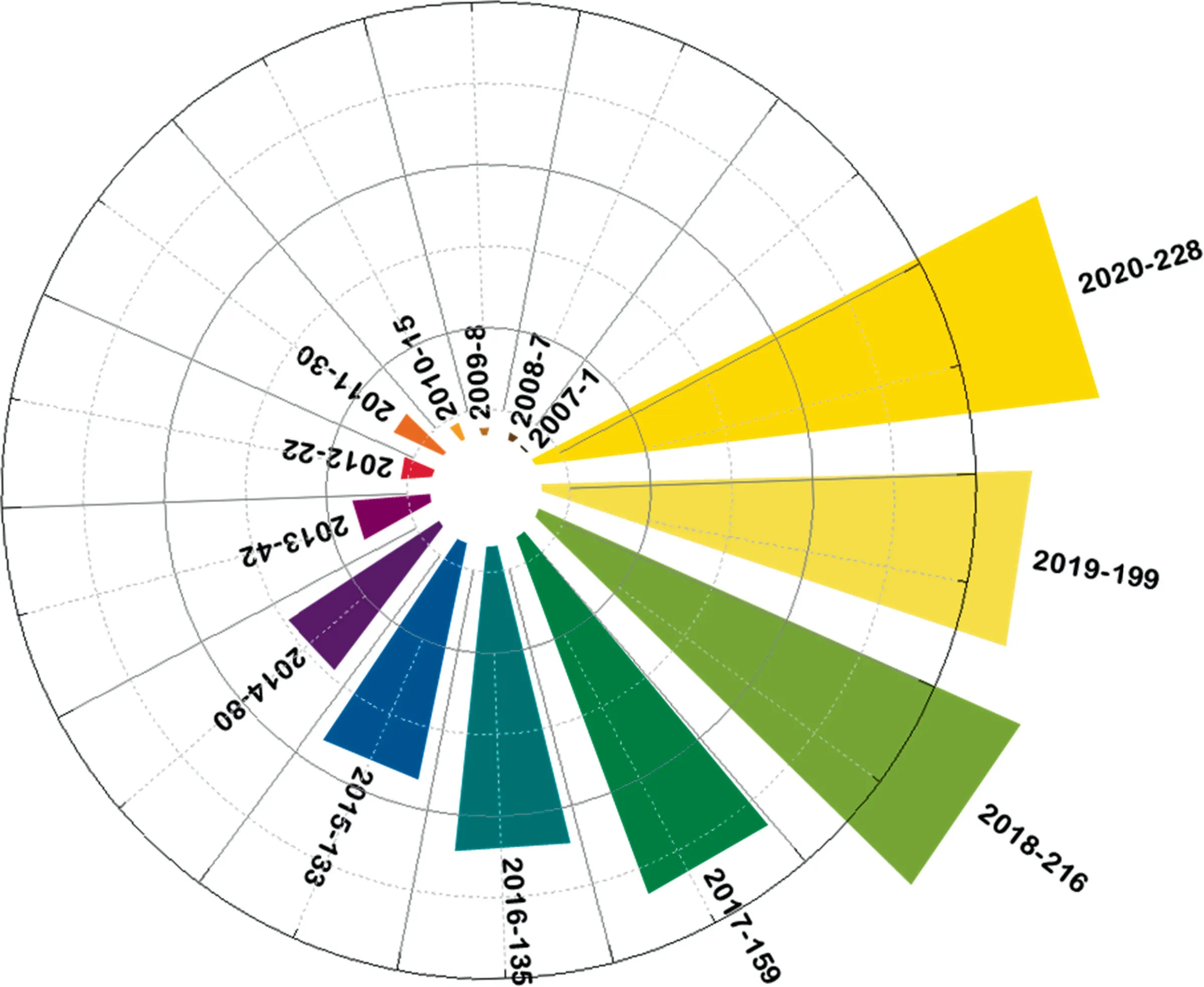
Fig.2. Annual publications on CMPs since their discovery(assessed 14th June 2021).Searched term of‘‘Conjugated Microporous Polymers”is from the topic search with Web of Science, Web of Science Core Collection database.
Many chemical reactions were employed in the synthesis of CMPs such as Suzuki-Miyaura coupling [59-61], Yamamoto coupling [62-64], Heck coupling [65,66], cyclotrimerization reactions[67-69], phenazine ring fusion [54,70,71], Schiff-base condensations [72-74], heterocycle linkages [75-77], oxidative coupling[78,79], and electropolymerization [7,33,34],etc.The wildly reported reactions are summarized in Fig.3.Taking Sonogashira-Hagihara cross-coupling reaction as an example, the reaction couples an aryl halide with an alkyne-containing monomer in an amine-based solution under the aid of palladium and/or copper cocatalyst.A series of CMP networks,i.e., CMP-1, CMP-2, and CMP-3, were synthesized in this way [35].These polymers exhibited good chemical stability, thermal resistance, and high surface area.The rich carbon-carbon bond formation chemistry and the broad choice of ligands with various functionalities endow CMPs with a wealth of opportunity and great potential in different chemical, electrical and optical applications.

Fig.3. Reaction schemes for the synthesis of CMPs [80].
3.Fabrication Routes of CMP Membranes
Most CMPs are insoluble in common solvents.This property,on the one hand,is beneficial for solvent resistance,while on the other hand,excludes the application of the most common solution-based membrane preparation processes such as the phase inversion techniques [81].To achieve a thin film/membrane immobilized onto porous supports or micro/nanoparticle surfaces,various innovative membrane fabrication methods have been developed, including surface-initiated polymerization(SIP),space-confined polymerization,layer-by-layer deposition,and electropolymerization,as some typical examples summerized in Table 1.

Table 1CMPs materials, fabrication routes, and related membrane applications
3.1.Surface-initiated polymerization
Surface-initiated polymerization (SIP) is one of the most widely-reported methods for preparing covalently grafted thin polymer films on surfaces modified with initiator-bearing monolayers [91,92].Polymers with reactive end groups can be grafted onto the functionalized surfaces or particles.The notable advantage of the membranes made by the SIP method is their superior mechanical and chemical robustness.In addition, the introduction of a variety of functional groups enables a high degree of synthetic flexibility.With the discovery of chain-growth polycondensations of AB-type CMP monomers by McCulloughet al.[93]and Yokozawaet al.[94], the preparation of complex topologies of conjugated polymersviaSIP became feasible.
Lianget al.[82]used the surface-initiated polymerization strategy through C-C coupling reactions for preparing CMP membranes(Fig.4).Firstly, 1-bromo-4-(trimethylsiloxy) benzene was grafted onto a thin SiO2layerviahydrolysis reaction.The initiator surfaces are then exposed to the solution containing catalyst and monomers.The reaction mixture was heated at 100°C for 72 h to generate the membrane.The membrane with the substrate was then washed and dried under vacuum overnight.Finally, the resulting CMP membrane was transferred to porous support for further tests.The developed CMP membranes showed high structural rigidity with Young’s modulus of 4-6 GPa as well as high microporosity with Brunauer-Emmett-Teller (BET) surface areas of 383-593 m2·g-1.The all-rigid conjugated backbone of the CMP membrane showed high resistance to organic solvents.As a result, the membrane exhibited great potential for application in organic solvent nanofiltration,which will be further discussed in Section 4.A similar surface-initiated polymerization strategy was reported by Huanget al.[95].As compared to the 42-nm-thick CMP membranes supported on polyacrylonitrile substrates reported by Lianget al., a porous SiO2substrate is used as the support layer in Huang’s work.The thickness and morphology of the CMP skin layer were modified by changing the concentrations of the monomers and solvent.The high content of micropores and the presence of chiral moieties within the microporous CMP polymers lead to excellent enantiomeric resolution performance.The prepared organic-inorganic composite CMP membranes showed great potential in enantioseparation.The permeability and enantioselectivity for racemic phenylalanine and tryptophan in aqueous solution were 2.07 × 10-5m2·h-1, 1.17 × 10-5m2·h-1, and 94.1%,84.9%, respectively.Compared with other fabrication routes, the SIP strategy has particular advantages in preparing the CMP composite membranes, which endows better mechanical properties between the CMP functional and support layers.
3.2.Space-confined polymerization
Shaoet al.[83]reported a space-confined polymerization strategy to prepare molecular-sieving CMP membranes, as shown in Fig.5.As reported, the polymerization of the monomers occurred inside the commercial polysulfone (PSU) ultrafiltration membrane at an organic/water liquid-liquid interface with catalyst.After a 7-days reaction at room temperature, the CMP membrane was collected and washed.Finally, the membrane was activated in a vacuum oven under 60 °C for 12 h before characterization.The mesoscopic voids in the ultrafiltration membrane were divided by CMPs into ultra-micropores, which offered outstanding molecular-sieving properties for the membrane.The membrane showed stable separation performances in the 7-day continuous tests and 6-month aging tests due to the minimized chain conformational relaxation that benefitted from the highly cross-linked aromatic networks.

Fig.4. Surface-initiated polymerization of the CMP membrane on a bromobenzene-functionalized Si/SiO2 substrate [82].

Fig.5. Schematic illustration of the preparation of CMP membrane via space-confined polymerization and the chemical structures of the monomers[83].
3.3.Layer-by-layer deposition
Another available chemical synthesis methodology is layer-bylayer (LBL) deposition, a common approach for fabricating multilayer thin films or membranes with precisely controlled thickness and composition on a nanometer scale [96].Lindemannet al.[85]successfully prepared ~10 nm-thick CMP membranes using the LBL method (Fig.6).Two different types of monomers, tetrakis(4-azidophenyl)-methane (TPM-azide) and tetrakis(4-ethynylphe nyl)-methane (TPM-alkyne), were used in this work.Each monomer has multiple copies of the same functional group.The two monomers were complementary to each other and could react in high yield without forming side products.The two monomers,TPM-azide and TPM-alkyne, were supplied alternatingly to the modified substrate together with Cu(I) catalyst.The thickness of the CMP membrane was controlled by altering the growth cycle.Atomic force microscopy (AFM) revealed that the homogeneous CMP thin film had a thickness of about 1 nm per growth cycle.Similar to the surface-initiated polymerization method,the templated substrate used for the LBL method also needs modification.To drive the quasi-epitaxial growth, the choice of functionalization method of the templated substrate was found the crucial step for the successful fabrication of the CMP membranes.
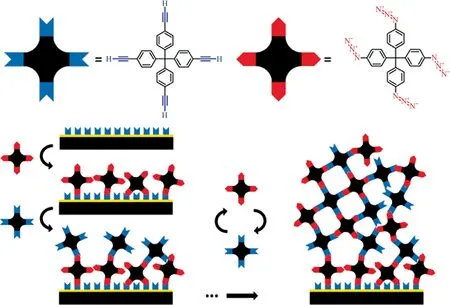
Fig.6. Schematic illustration of the preparation of CMP membrane via layer-by-layer deposition [85].
3.4.Electropolymerization
Electropolymerization (EP) offers a simple and scalable platform for creating nanofilms, whose thickness, pore size, surface properties, and chemical composition are all controllable at the nano length-scale by adjusting the scanning cycles rate, potential windows,and other electrochemical parameters.The development of EP can be dated back to the 1970s when Seoet al.[97],Ambroseet al.[98], and their coworkers introduced the method in polymer synthesis.It was late widely applied in the fabrication of nanofilms used as optoelectronic devices and chemical sensors [99-101].Compared to the traditional polymerization methods, the main advantage of EP is that the polymerization occurs homogeneously over the entire surface, which avoids powder formation.Besides,the setup used in the EP process is simple.Typically,it is comprised of a three-electrode cell connected with an electrochemical workstation.Since the thickness of the membrane can be obtained at nanoscale,both the membrane production cost and mass transport resistance are expected to be small.
The electropolymerization mechanism is still under exploring.The generally accepted mechanism at present is shown in Fig.7,which uses carbazole as an example[7,102-104].The polymerization process involves three steps in each cycle of the cyclic voltammetry (CV) scan: electro-oxidation, coupling, and electroreduction.Firstly,the carbazole monomers in the positive CV scan are oxidized to form unstable cation radicals.The cation radicals then react with either another monomer or each other to produce dimeric carbazoles and lose two protons.For N-substituted carbazoles, 3,3′-bicarbazyls will be formed as the main product.The formed dimeric carbazoles are further oxidized into cation radicals and quinoid di-cations.These cation radicals reduce to their neutral state in the final cathodic sweep scan.Multiple cycles are required to form a 3D interconnected CMP structure.In the subsequent scan cycles, the reduction and oxidation peak currents will both increase from the previous cycles, resulting in an enlarged CV profile.With the chain extension and the formation of oligomers and polymers, the solubility decreases gradually, and the CMP membrane is thus gradually deposited on the electrode.As reported, the reaction efficiency of the electro-oxidative coupling reaction is near 100%, and the resulting highly cross-linked films are stable in various organic solvents [33].
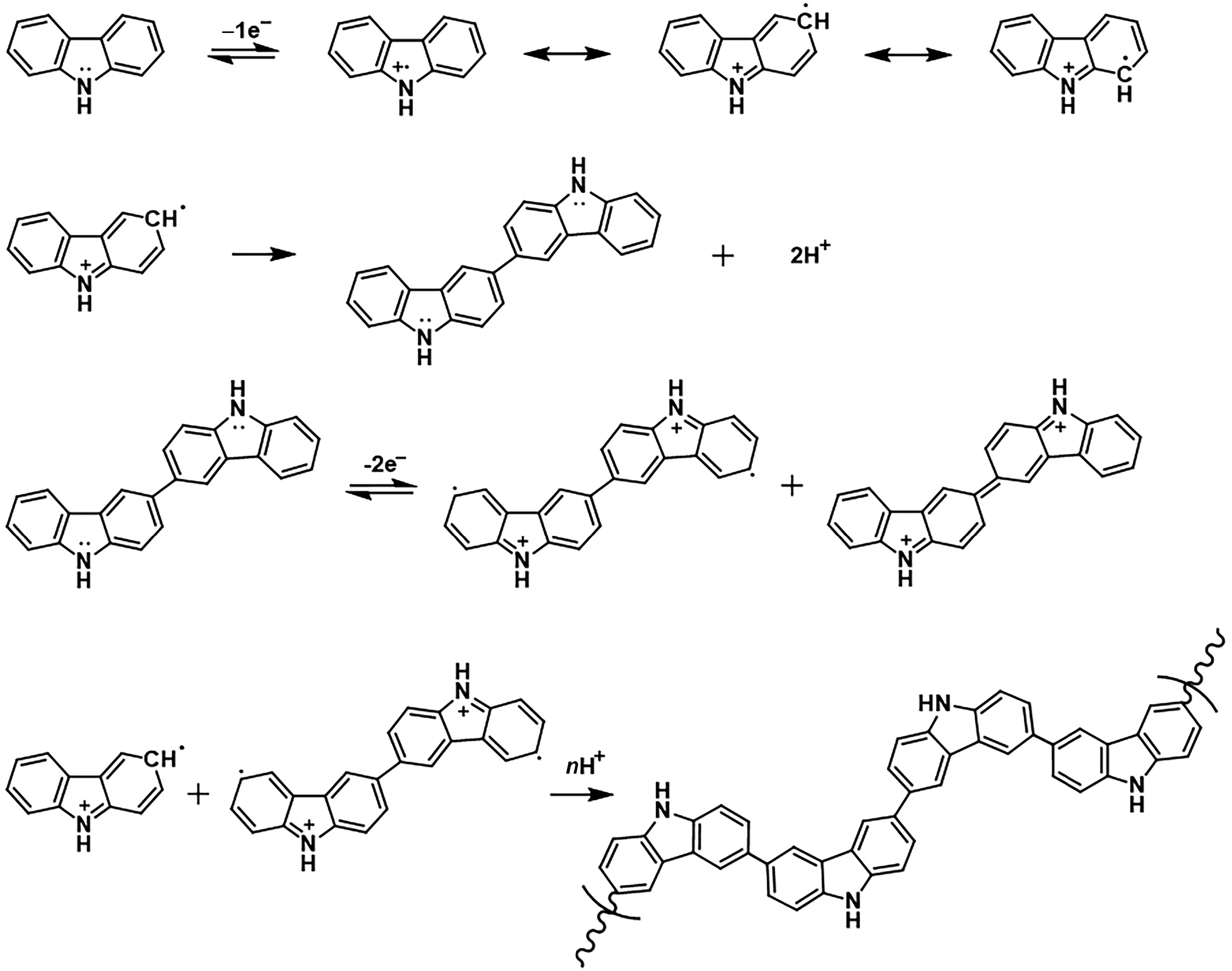
Fig.7. Mechanism of unsubstituted carbazole monomer oxidation, cross-linking, and reduction during the CV scans.
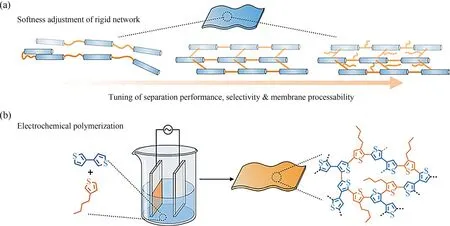
Fig.8. (a) Schematic illustration of the softness adjustment of rigid networks (SAR) strategy.(b) Schematic illustration of the preparation of CMP membrane via coelectropolymerization [29].
CMP membranes prepared by the EP method are typically too brittle to be used in pressure-driven processes due to the rigid molecular structure[7,29].To overcome this drawback,Zhanget al.[29]reported a softness adjustment of rigid networks (SAR) strategy to fabricate molecular-sieving polythiophene membranes based on the electropolymerization method (Fig.8).In this work,14 polymers were designed and prepared by adjusting the active polymeric sites and the alkyl chain length of the monomers.By incorporating rigid building units bearing flexible alkyl chains,Zhanget al.[29]successfully softened the rigid network without sacrificing the permanent pores of the CMP membranes.This SAR strategy provides a rational design on the molecular level to fabricate flexible CMP membranes.
Instead of modifying the monomers, we developed a different method to prepare flexible CMP membranes [7].Bio-inspired by the spider silk nanocomposite structure composed of a bundle of fibrils embedded in a non-crystalline matrix, we reported a novel strategy to enhance the mechanical properties of CMP membranes(Fig.9).A porous polydopamine modified carbon nanotubes(PDACNT)support was used as a robust and conductive core scaffold.A polycarbazole film was prepared inside the PDA-CNT network from a rigid conjugated monomer, 2,2′,7,7′-tetra (carbazol-9-yl)-9,9′-sp irobifluorene (SpCz), by electropolymerization approach.The resulting composite membrane showed a typical sandwich structure that comprised of three regions from the surface to the center:top dense polycarbazole layer, intermedia composite layer, and center PDA-CNT region.The composite structure of CMP and 2D geometry greatly increased the mechanical strength and ductility of the membrane.The optimized CMP composite membrane showed a tensile strength of 26.5 MPa with a ductility of 18.9%.The average Young’s modulus reached up to 3.0 GPa, which was~5-8 times higher than that of the reported polyamide membranes [82,105].Besides, the use of the PDA-CNT network had many other advantages.The permeance of the PDA-CNT support was 2-3 orders of magnitude higher than that of traditional polymer supports with similar pore size [106,107], which was attributed to the decreased transport resistance.More importantly, the conductive, thermally stable, and mechanically strong PDA-CNT support could directly serve as the working electrode.This strategy thus provided a simple method to synthesize robust CMP membranes for pressure-driven separations processes.
4.Applications of CMP Membranes
4.1.Organic solvent nanofiltration
The separation and purification of organic solvents play a remarkable role in industries [8,107-109].Separating organic solvents to facilitate the reuse and remanufacturing are significant not only in reducing costs but also in environmental protection.The traditional technologies such as distillation [110,111]and extraction [112]require a large quantity of energy, high temperature, or a secondary separation process.These shortcomings greatly limit their further applications in the separation and purification of organic solvents.Organic solvent membrane-based separation processes have attracted significant attention in industrial applications due to their distinct energy advantages over traditional separation processes.
As mentioned above, CMP membranes have a rigid and permanent pore structure as well as great chemical stability,which facilitate the molecular separation in the organic solvent nanofiltration process.In our previous work [7], the CNT-CMP composite membranes showed strong chemical stability.The membrane was stable in acetonitrile, acetone, heptane, methanol, ethanol, and 2-propanol.The CMP membranes also exhibited a highly uniform pore size distribution,equivalent to or even superior to crystalline porous COF and MOF membranes [113,114].Therefore, the resulting CMP composite membranes showed excellent molecular sieving capability.The molecular weight retention onset (MWRO)and the molecular weight cut-off (MWCO) of the optimized membranes were determined to be ~300 and 540 Da,respectively.The difference between MWRO and MWCO was only 240 Da.Such a precise molecular sieving capacity in organic solvent nanofiltration is much better than other reported porous polymer membranes [82].In addition, stable methanol permeance of 280 L·m-2·h-1·MPa-1was achieved, which was higher than most reported organic solvent nanofiltration membranes [115-117].The transport of the organic solvent molecules inside the prepared CMP membranes is mainly governed by the pore-flow mode.The permeance showed a linear relationship with the reciprocal of the solvent viscosity.The mass transfer mechanism is the same with the reported COF membranes[114]and CMP membranes[82].The high permeance and precise molecular sieving originated from the high surface area (548 m2·g-1) and uniform pore size.

Fig.9. Surface(a)and cross-section(b)SEM images of the CNT composite CMP membrane.Stress vs.Strain curve measured by the standard tensile test(c),Inset:photographs of a CNT-EP-PC15 membrane and an ITO-EP-PC15 film fabricated on the dense ITO glass.Photograph of the flexible CNT-EP-PC15 membrane(d);Photograph of the CNT-EPPC15 membrane holding a vial bottle and ten metal blocks (e)[7].
Using three different dibromobenzenes, 1,4-dibromobenzene,1,3-dibromobenzene and 1,2-dibromobenzene, Lianget al.[82]fabricated three highly cross-linked CMP membranes based on the surface-initiated polymerization, which were namedp-CMP,m-CMP, ando-CMP, respectively.The all-rigid porous CMPs membranes composed of only chemically inert C-C and C-H bonds exhibited high performance in organic solvent nanofiltration.First,p-CMP andm-CMP exhibited similar rejection properties to dyes in ethanol.The MWCO was around 560 g·mol-1.When using protoporphyrin-IX (PPh-IX), which had a molecular weight of 562.7 g·mol-1with a size of 1.47 nm,as a guest molecule,the rejection was near 100%.It indicated that the rejection was originated dominantly from the pore-size exclusion because the molecular size of PPh-IX was much closer to the diameter(1.5 nm)of the largest pores in thep-CMP membrane.However, since theo-CMP membrane has relatively larger pores with a size of 2.2 nm, the rejections of all dyes in the tests were lower than 90%.A 100-h test confirmed the excellent long-term stability of the CMP membranes.Moreover,the structural tunability of the CMP membranes was also demonstrated by introducing reactive -OH moieties on the pore surfaces and obtaining hydroxyl-functionalized CMP membranes (p-CMP-OH).Further, the pore size was tunedviapost-modification ofp-CMP-OH membranes by alkyl moieties of different sizes.As a result, the permeance and dye rejection of these membranes were changed accordingly.However, shrinking the pore sizeviapost-modification always resulted in permeance decay.Designing a membrane with both high permeance and controllable selectivity is still challenging.Molecular simulations were performed in this work to help understand the relationship between the porosity of CMPs membrane and its separation performance.The results further confirm that all rigid CMPs membranes have higher surface areas and porosity than traditional polymer membranes.
Heet al.[118]reported a novel strategy to finely tune the pore size of CMP membranes at the angstrom scale(Fig.10).The MWCO of the membrane can be effectively adjusted without a considerable permeance decrease.Firstly, using the EP method, the TTBCMP membrane was synthesized from monomer 1, 3, 5-tri (2-thienyl)-benzene (TTB).Compared to the CMPs with only inert C-C and C-H bonds, the thiophene units in the TTB-CMP membrane can be readily oxidized into thiophene S, S-dioxide derivativesviapost-modification.By filtrating them-chloroperbenzoic acid (m-CPBA) solution through the TTB-CMP membrane, TTBCMPO membrane was obtained.Accordingly, the pore size was reduced precisely from 1.73 nm in the TTB-CMP membrane to 1.48 nm and finally to 1.18 nm in the TTB-CMPO membrane.Thus,the post-oxidation had precisely reduced the pore size by 0.25-0.30 nm, which was consistent with the theoretical value of~0.28 nm based on the S=O double bond length of 0.14 nm.The pristine TTB-CMP membrane showed a rejection of 72.1% to PPh-IX.At the same time, the rejection was greatly increased to 96.5%in the TTB-CMPO membrane.The methanol permeance decreased from 320 L·m-2·h-1·MPa-1to 210 L·m-2·h-1·MPa-1.Although the permeance dropped by ~34%, considering the significant decrease of MWCO from 800 to 500 g·mol-1,this permeance was still much better than commercially available organic solvent nanofiltration membranes.

Fig.10. Scheme of controlling MWCO of TTB-CMP membranes through pore size tuning via post-modification of thiophene moieties [118].
4.2.Ion sieving
Ion sieving has found broad applications in salinity gradient energy conversion, ion-exchanging, flow batteries, and signal transfers.Compared with the separation of dyes and solvents, ion sieving is usually more challenging because of their similar sizes that require a higher level of pore-size uniformity.Recently, we demonstrated the fabrication of CMP composite membranes for ion sievingviathe easy-to-scale-up EP strategy (Fig.11) [89].The prepared CMP membrane using 1,3,5-tris(N-carbazolyl) benzene(TCB) as the starting monomer showed rigid and intrinsic pores with a size of 0.84 nm,which matched with the predicted pore size of ~0.85 nm from the molecular simulations.The membrane showed a BET surface area of over 800 m2·g-1.The membrane was comprehensively tested under pressure-driven,concentration-driven, and electrical-driven ion separation processes,using nine inorganic salts and four organic solutes with different sizes and charges.The optimized CMP membrane exhibited a hydrated diameter cut-off (HDCO), defined at 90% rejection, of~0.95 nm; and a hydrated diameter retention onset (HDRO),defined at 10% rejection, of 0.9 nm.The difference between HDCO and HDRO was only 0.05 nm, indicating the excellent ion sieving performance in the pressure-driven process.When tested in a concentration-driven process, the membrane showed a K+permeation rate of 2.1 mol·m-2·h-1·MPa-1with K+/Al3+selectivity of 134 and K+/[Fe(CN)6]3-selectivity of 436.
The current observed in the electrical measurements with an Mg2+solution was 0.446 μA at 0.1 V, which was more than 20 times higher than that observed using [Fe(CN)6]3-.The difference in the hydrated ionic sizes of Mg2+and [Fe(CN)6]3-was 0.094 nm.Therefore, the CMP membrane also showed a high ion sieving performance at a sub-angstrom precision.Molecular simulations revealed that the precise ion-sieving performance of the CMP membranes originated from the uniform pores and narrow pore-size distribution [89].
Although the carbon nanotubes supported CMP membranes have very good performance in both molecular sieving and ionic sieving,the rigidity nature of the conjugated CMP materials results in the dependency of CMP membranes on the composite structure.The composite membranes are usually thicker, which leads to relatively high molecular/ionic resistance.In order to further enhance the performance of the CMP membranes, designing these membranes with flexible, homogeneous, and freestanding structure is potentially an effective solution.Recently,we reported the flexible and ionic CMP membranes designed based on the molecular level[90].The integration of ionic modules into CMP frameworks forms the charged channels within the confined nanoscale space.As a result, the ion transport inside the ionic CMP membrane is dually controlled by size and charges, and thus the ion selectivity is further increased.The ion permeation test showed that the prepared 40 nm thick CMP membranes exhibited an equivalent ion permeation rate to the commercial membranes but approximately 10 times higher ion selectivity.
4.3.Gas separation

Fig.11. (a)Cross-section SEM image of CMP@100-20c.The inset SEM image shows the flexibility of the composite membrane.(b)Membrane performance in a concentrationdriven process.(c) K+ permeation rate vs K+/Al3+ (red edge) or K+/[Fe(CN)6]3- (blue edge) selectivity for CMP@100-20c membrane in the concentration-driven process.(1 bar = 0.1 MPa).
Conventional polymeric membranes have great advantages in cost, preparation, and stability compared with the membranes made by crystalline porous materials such as metal-organic frameworks(MOFs)and covalent organic frameworks(COFs).Therefore,conventional polymeric membranes dominate the commercial market in the gas separation field.However,the flexible polymeric chains can easily slid over each other, resulting in the broad pore size distribution of polymer membranes, which hinders their gas separation performance.The relatively rigid CMPs materials provide an effective way to prepare gas separation membranes with highly uniform pore structures.CMPs membranes have intrinsic and permanent open channels benefitting from the rigid conjugated structure, which is superior to the traditional polymer membranes and facilitates gas separation.Zhanget al.[29]prepared gas separation CMP membranesviathe EP method.The porosity and rigidity of the membranes were tunedviathe SAR strategy for H2/CO2separation.The CMP membrane showed a selectivity up to 50 and an H2permeability of 626 Barrer(1 Barrer= 7.52×10-18m3·(STP)·m-2·m·s-1·Pa-1).The performance was far beyond the Robeson upper bound and the best reported pure organic polymer membranes.The H2diffusivity reaches 5120 × 10-8cm2·s-1, and for CO2, the diffusivity is only 11×10-8cm2·s-1.The result reveals that diffusion rather than dissolution plays the dominant role in the gas transport inside the CMP membranes.In addition, the optimized CMP membrane exhibited outstanding performances for H2/N2and H2/CH4separations,which also surpassed their Robeson upper bounds.Positronium annihilation lifetime spectroscopy (PALS) verified the formation of micropores with suitable sizes in the membranes.Mechanistic studies showed that the high selectivity was attributed to the size-exclusive property of the membrane.The pore architecture and the chemical stability of CMP membranes were both superior to conventional polymer membranes.The covalently linked CMP membranes are robust and stable in acidic (2% (vol)H2S) and thermal conditions (120 ℃), enabling steady separation of H2from H2S and other erosive gases under elevated temperatures up to 120 ℃.It indicates the great potential in industrial H2separation processes.The same group also reported the fabrication of CMP membraneviathein situpolymerization strategy[83].The resulting CMP membranes showed high performance in the separation of H2/CO2, H2/N2, and H2/CH4, which further revealed the potential of CMP membranes in the application of gas separations.
A Sub-10 nm freestanding CMP-nanomembrane was developed by Lindemannet al.[85]vialayer-by-layer deposition on a sacrificial substrate.The CMP-membrane exhibited an apparent molecular sieving effect in gas separations.Although the membrane showed a selectivity of ~36 for H2/N2, the permeability for H2was only ~4 Barrers, which was lower than expected and also lower than the Robeson upper bound.The authors proposed that the poor interconnection of pores could be the possible reason for the low permeability, but this assumption still needs to be proved by further studies.
4.4.Other applications
In addition to the application of molecular sieving, CMP membranes/films were also widely used in various fields, such as photo-redox catalysis,light emittance,sensing,and energy storage,as mentioned above.For example, recently, our group developed an ultrathin, compact, and conductive microporous (denoted as UCCM) CMP membrane for Li-S batteries based on the EP method(Fig.12) [120].The membrane pore size was ~0.82 nm, which could effectively block the diffusion of polysulfide species but facilitate the fast transport of lithium ions.In addition, the conductive CMP membrane (23 S·m-1) was beneficial for charge transfer and redox reactions.Using the UCCM type of CMP membranes as interlayers have greatly enhanced the sulfur utilization by three times.The Li-S battery showed a reliable high capacity of 10 mA·h·cm-2at a sulfur loading of 11.2 mg·cm-2.
Our group further developed a nano skin concept in Li-S battery[119].A thin CMP membrane was prepared by the EP method to encapsulate the sulfur cathode entirely, as shown in Fig.12.The ultrathin CMP nano skin contained uniform micropores of approximately 0.8 nm.It prevented the shuttling effect of polysulfide species, allowed fast transport of lithium ions, and enhanced the utilization of electrolytes.As a result, the Li-S batteries using the CMP nano skin showed a prolonged lifetime (1000 cycles) and superior stability.At a low electrolyte/sulfur ratio of 4 μl·mg-1,the cathode exhibited a practical energy density of over 300 W·h·kg-1without the use of any sophisticated hosts.
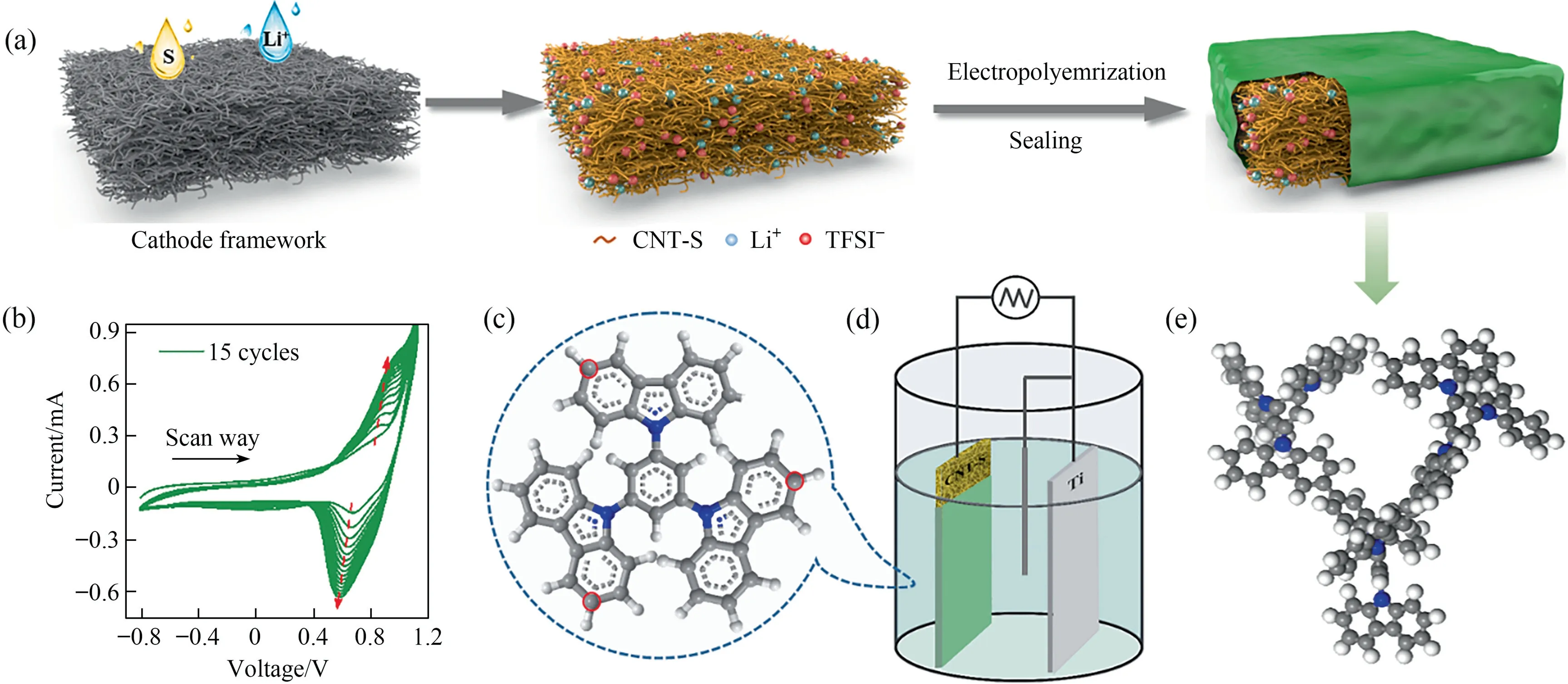
Fig.12. (a)Schematic illustration of the fabrication of CMP-CNT-S cathode via the electropolymerization sealing process.(b)CV curves of TCB electropolymerization at a scan rate of 30 mV·s-1.(c)Structure of carbazole-based TCB monomer.The gray and blue balls represent carbon and nitrogen atoms,respectively.The carbons indicated with red circles are the active polymerized sites.(d)Setup of a three-electrode electropolymerization cell.(e)The elementary microporous structure of the polymerized nano skin was obtained by DFT simulation [119].
5.Conclusions and Perspectives
Compared to conventional polymers,CMPs have rigid molecular structures,uniform pore size,high surface area,high chemical and thermal stabilities,and unique electrical and optical properties due to the conjugated covalent bonding.All these are prominent properties for membrane applications.Therefore, it is expected that CMP membranes will find profound applications, especially in the following directions.
(1) Preparation of high-performance membranes.The reported applications of CMP membranes varied from hydrogen separations to organic solvent nanofiltrations.It indicates that the pore size of CMP membranes can be systematically tuned from sub-nanometer to nanometer scales.Hence,CMP membranes can be in principle applied to any separation systems that a microporous membrane can be done,including gas separation, water desalination, ionseparation, and nanofiltration.The uniform pore size and high surface areas make it possible to break the permeability-selectivity trade-off limit of conventional polymer membranes.Especially, most of the developed membrane fabrication methods such as layer-by-layer deposition and electropolymerization have shown the capability to control the membrane thickness on the nanometer scales.Ultrathin membranes less than 100 nm thickness can be readily obtained on a large scale.Furthermore, the intrinsic cross-linked porous network may suffer less from the plasticization effect.All these properties will render CMP membranes with performance standing out of many other membrane systems and the ability to apply to challenging but valuable separation systems such as closeboiling hydrocarbon mixtures and recovery of organic solvents.
(2) Preparation of functional membranes.The whole organic nature of CMPs allows easy functionalization, which provides numerous possibilities to change the surface properties for special applications.For example, functional groups with special chirality, charge, hydrogen bonding, hydrophobicity,etc., can be grafted to the membrane structure.CMP membranes with these special functional groups can find broad applications in chiral separation, biological separations, batteries, or other energy conversion devices,etc.
(3) Preparation of smart membranes.Membranes have been widely used in electrochemical processes such as electrodialysis.Many CMPs are conductive or semiconductive.This unique property may provide innovative ways to combine the membrane process with electrical and/or optical processes.For example, the membrane can directly serve as the electrode and build a much strong electrical field inside the membrane.The membrane can be made electrically and/or optically sensitive and used as a smart material in novel applications such as chemical catalysis and sensors.
However,there are also many challenges in the development of CMP membranes.The first is the mechanical strength.The rigid CMP structure gives the membranes unique pore architecture,which is in favor of permeability and selectivity.Meanwhile,it also sacrifices the flexibility and mechanical strength of the membranes.Therefore, to enhance the mechanical strength of the CMP membranes, molecular design or structure optimization should be considered.Secondly, the fabrication routes of CMP membranes need further exploration.Most of the current studies still focus on the synthesis of CMP powder, not membranes.It is often not a trivial task when adapting the synthesis from powder to membrane since the latter may be limited by many practical considerations,such as scalability,safety,and cost.Finally,the pore formation mechanism of CMPs is not clear.Very few studies in the current literature have attempted to understand in detail how the CMP monomers are linked to form the relative uniform pore size,while rational design and control of the pore size and pore size uniformity are crucial in precise size separations.
Overall, the development of CMP membrane/film still remains in its infancy.However,the excellent properties of CMPs compared to conventional polymers have shown great potential in chemical separations.It will attract more and more attention and emerge as an important type of novel membrane material.
Declaration of Competing Interest
The authors declare that they have no known competing financial interests or personal relationships that could have appeared to influence the work reported in this paper.
Acknowledgements
The work was supported by the King Abdullah University of Science and Technology, Saudi Arabia, under the competitive research grant URF/1/3769-01.
 Chinese Journal of Chemical Engineering2022年5期
Chinese Journal of Chemical Engineering2022年5期
- Chinese Journal of Chemical Engineering的其它文章
- Notes for Contributors
- Solubility determination and thermodynamic modeling of bis-2-hydroxyethyl terephthalate (BHET) in different solvents
- Insights into the cross-amyloid aggregation of Aβ40 and its N-terminal truncated peptide Aβ11-40 affected by epigallocatechin gallate
- Numerical study on hydrodynamic characteristics of spherical bubble contaminated by surfactants under higher Reynolds numbers
- Spray-drying assisted layer-structured H2TiO3 ion sieve synthesis and lithium adsorption performance
- Innovative hydrophobic/hydrophilic perfluoropolyether (PFPE)/polyvinylidene fluoride (PVDF) composite membrane for vacuum membrane distillation
